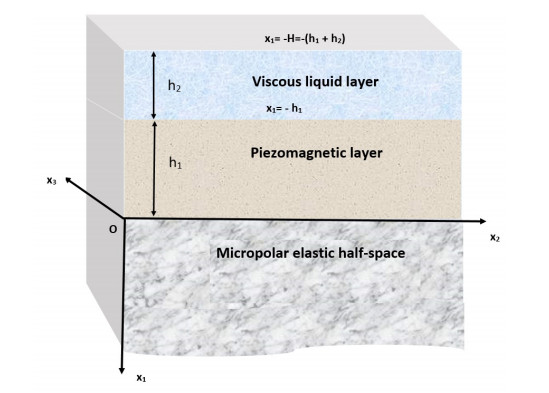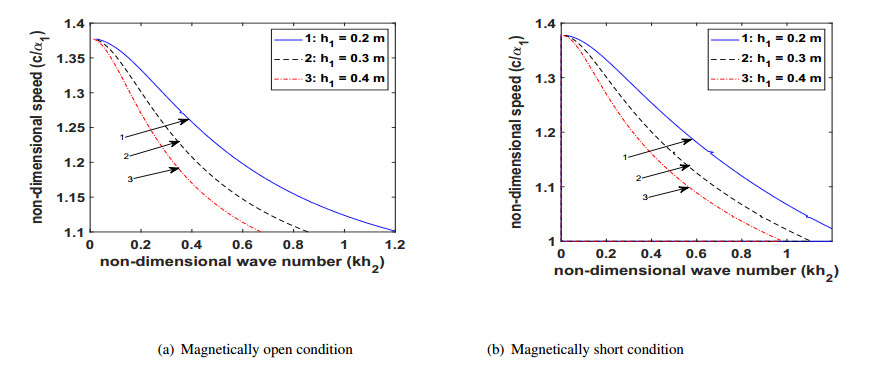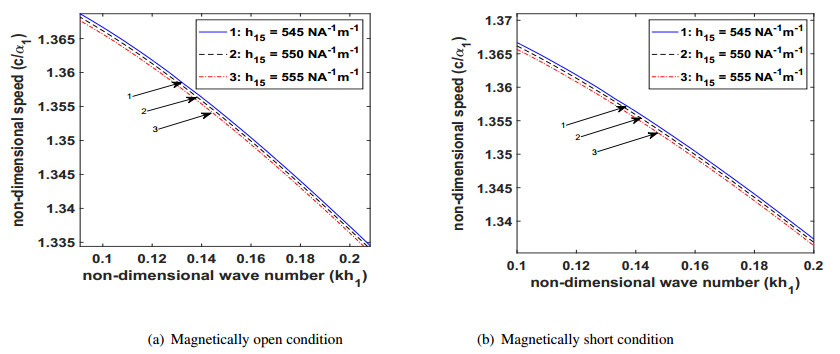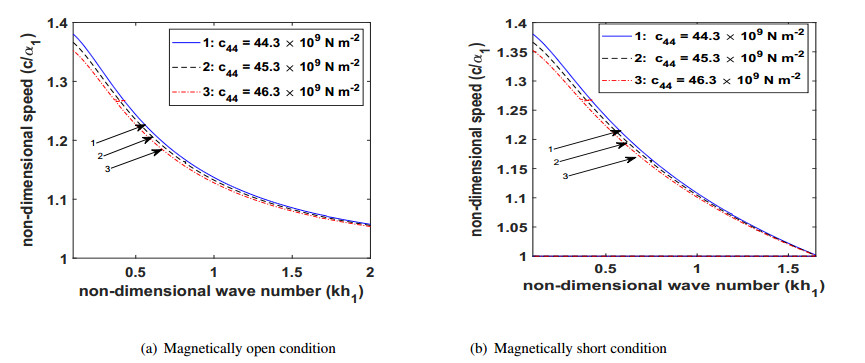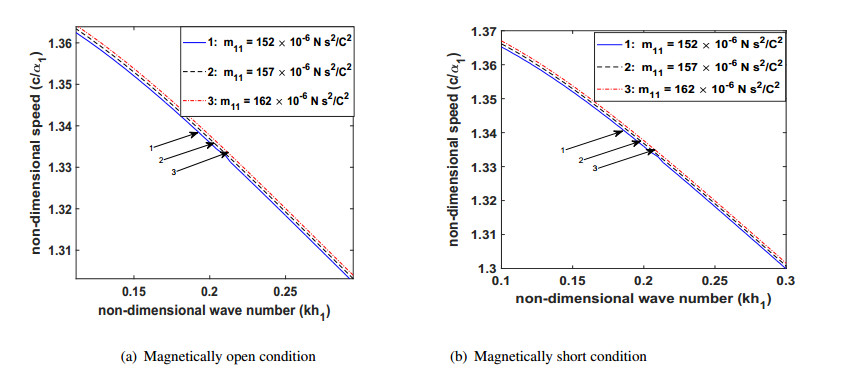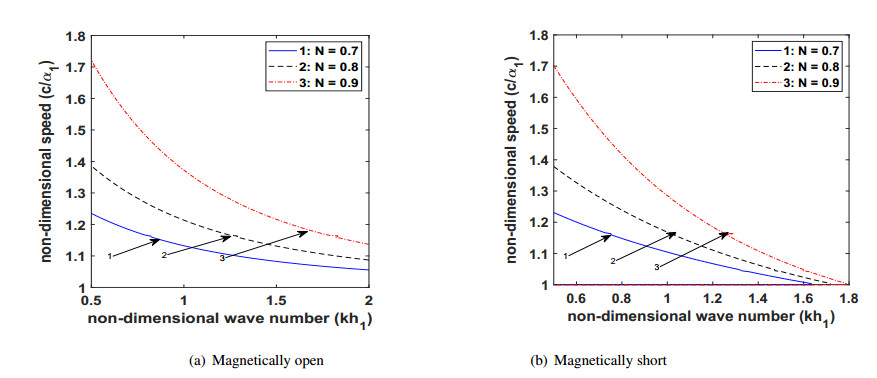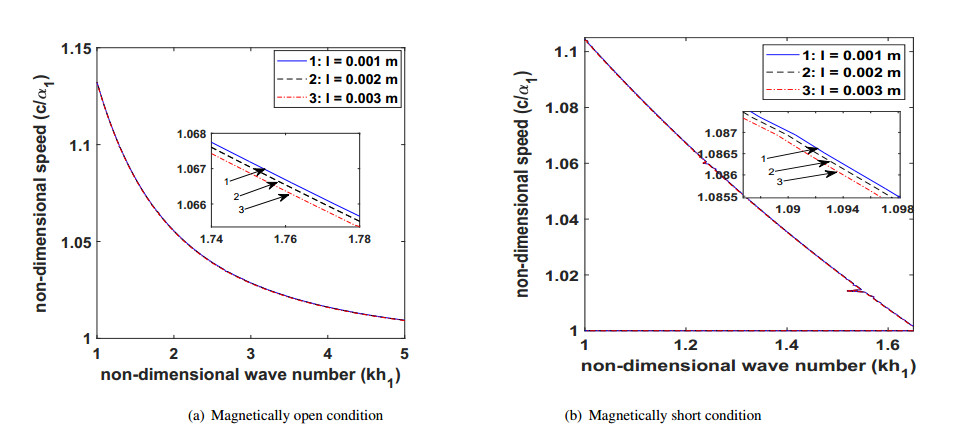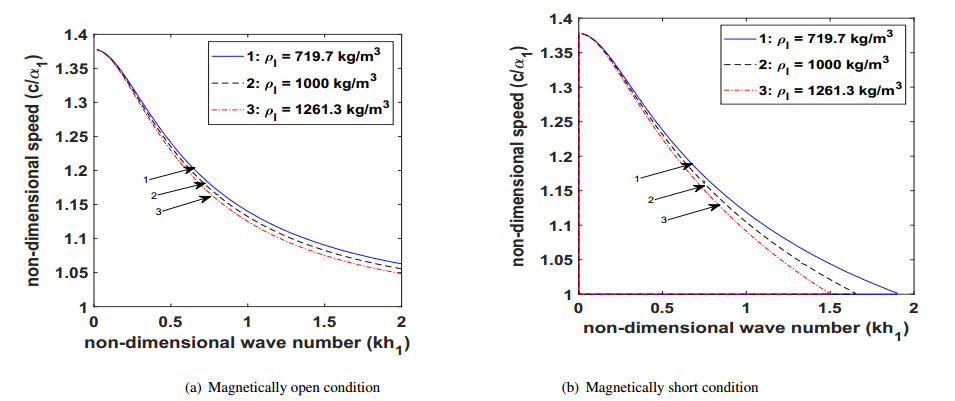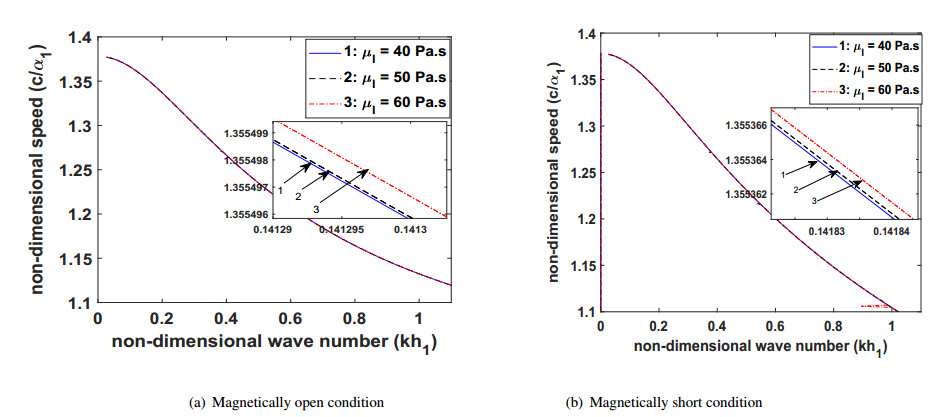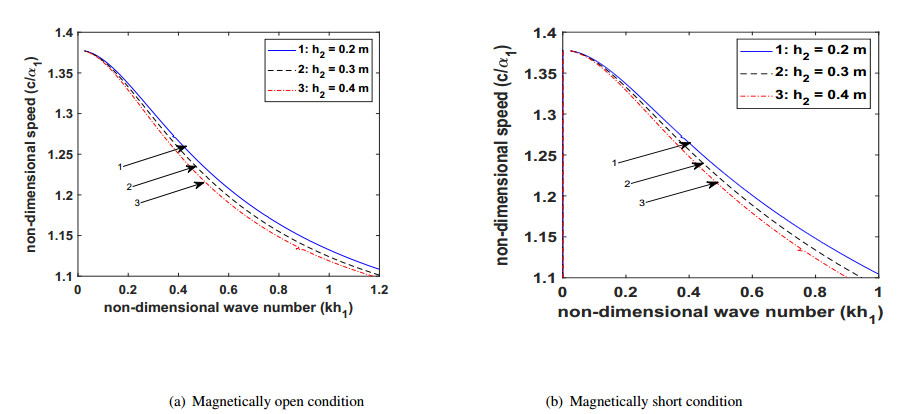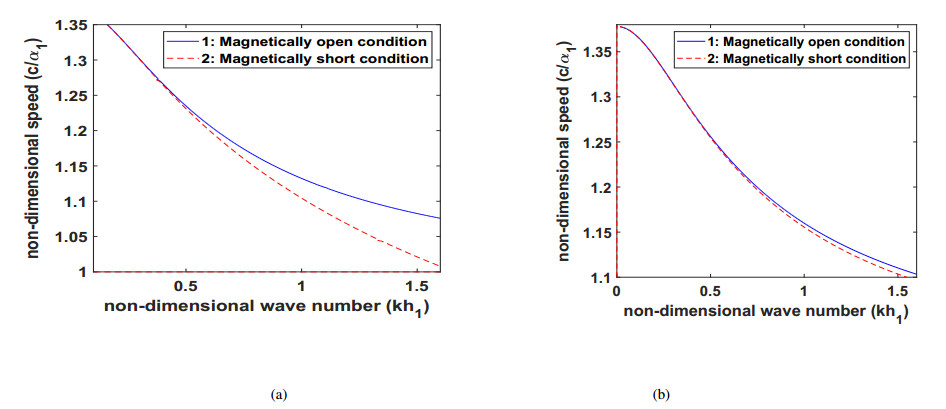The aim of the present study is to unravel the concealed attributes of the Love-type wave propagating in a composite of CoFe2O4 laden with Newtonian viscous liquid (VL), resting over Aluminium-Epoxy as a semi-infinite micropolar (MP) substrate bearing size dependent properties. The admissible boundary conditions are used to obtain the dispersion relations for both magnetically open and short cases. To support the findings and reverberations of affecting parameters, graphical representations are provided. Probable particular cases are deduced and matched with the existing result. It can be perceived from graphical representations that phase velocity of Love-type wave is remarkably affected by these parameters. Findings may have meaningful practical applications towards the optimization of magnetic sensors and transducers working in liquid environment.
1.
Introduction
In the last few decades, fractional differential equations have become an active research topic due to their applications in many fields, such as computer science, biology, mechanics and nonlinear fractional-order Lorenz system[1]. To date, many researchers have conducted in-depth research on several fractional order derivatives and integrals, such as Caputo, Riemann-Liouville, Riesz and so on. In [2], they develop an extension of a quadrature method for solving a class of ψ-fractional differential equations by converting them to an equivalent linear Volterra integral equation as follows:
The Caputo-Hadamard fractional integrals are the special forms for ψ(t)=log(t) in (1.1). However, the Caputo-Hadamard fractional integrals are also very important for simulating different physical problems [3,4]. Recently, Caputo-Hadamard fractional differential integral equations have made a breakthrough in [5]. Therefore, in practice, the Caputo-Hadamard fractional integral equation is also worth further research. The purpose of this project was to construct an in-depth theory and application of the high-precision algorithm for Caputo-Hadamard fractional integral system on a uniform grid. To this end, we will study the following 2D nonlinear Caputo-Hadamard integral equation:
where K(s,t,τ,ω,f(τ,ω)), g(s,t) are known functions and f(s,t) is an unknown function in Θ=[a,b]×[c,d], Ω=Θ×Θ×R. We assume that the solution of (1.2) is smooth and K(s,t,τ,ω,f(τ,ω) satisfies the Lipschitz condition about the fifth variable.
In [6], a solution of the Caputo-Hadamard fractional differential equation based on a hierarchical grid is presented. In [7], the solution's existence and uniqueness of fractional Caputo-Hadamard type equations are given. In an existing reference [8], we consider the logarithmic decay and regularity of solutions of Caputo-Hadamard fractional diffusion equations. In [9], a new stable and high order uniform accuracy solution method is given for 2D nonlinear integral equations. In [10], the fractional stochastic differential equations solution's existence and uniqueness was proved by the fixed point method in the Caputo-Hadamard sense. In [11], they present three types of variable fractional orders in the Caputo-Hadamard sense. In [12], numerical methods for the initial singularity fractional equations were investigated by using the modified Laplace transform and FFT in the Caputo-Hadamard sense. In [13], they used the incomplete Gamma function to construct the time discretization scheme for Caputo-Hadamard fractional differential equations. In [14], a local discontinuous Galerkin algorithm based on the Gronwall inequality is proposed for fractional differential equations in the sense of Caputo-Hadamard. In [15], a kind of graded grid algorithm in the sense of Caputo-Hadamard is studied. In [16], they established a method for solving Caputo-Hadamard integrals and a class of fractional derivatives by using the logarithmic transformation of Jacobian polynomials. The calculation methods for three fractional differentials in the sense of Caputo-Hadamard have been given in [17]. In [18], they use uncertain fractional derivatives to discuss the price of European options. The research of Caputo-Hadamard equation can be found in [19], the applicant uses the spectrum method to give an algorithm for sets of Caputo-Hadamard fractional PDE. In [20], a numerical method for time-space fractional discrete systems in the sense of Caputo-Hadamard is given. For more information, please refer to [21,22,23].
In this paper, we will use a uniform mesh to solve 2D nonlinear fractional Hadamard integral equations based on the idea of [9], achieving uniform accuracy by using piecewise biquadratic logarithmic interpolations. For 0<γ,λ<1, we obtain an optimal convergence order of O(Δ4−γs+Δ4−λt) for a sufficiently smooth solution and a generalized nonlinear kernel function by using the Gronwall inequality based on the convergence analysis of a new technique.
The framework of this article is as follows. In Section 2, we give a high precision numerical method. The truncation error of the high order numerical method is mainly discussed in Section 3. In Section 4, the convergence of the high order numerical scheme is analyzed. In Section 5, two numerical experiments are presented to support our theory and demonstrate the efficiency of higher-order numerical methods. The final section summarizes the main contribution of the work and the future research work.
2.
Higher-order numerical scheme using two-dimensional nonlinear fractional Hadamard integral equations
Now, we can obtain an approximate evaluation of the Caputo Hadamard integral equations in two dimensions. In order to construct a numerical scheme for (1.2), we partition the domain Θ into 2Y×2X subdomains of equal size Δs=b−a2Y and Δt=d−c2X, where Y and X are positive integers. Assuming sn=a+nΔs and tm=c+mΔt, n=0,1,2,⋯,2Y, m=0,1,2,⋯,2X with a,c≥1, where a=s0<s1<⋯<s2Y=b and c=t0<t1<⋯<t2X=d are respective partitions of [a,b] and [c,d]. And we use fmn to represent a numerical scheme for (1.2) at a point (sn,tm), and we let Kmn(τ,ω,f(τ,ω))=K(sn,tm,τ,ω,f(τ,ω)) and gmn=g(sn,tm).
In this work, we present a high-order method for solving nonlinear fractional Hadamard integral equations. The basis functions of our approach are determined by the quadratic logarithmic interpolations of polynomials at points sn,sn+1,sn+2 and tm,tm+1,tm+2, and they are assumed to be φnk(τ),k=0,1,2;n∈N and ϕmk(ω),k=0,1,2;m∈N, respectively, and they are defined as follows:
In what follows, we construct the numerical scheme approximation to f(s,t) at a point (s1,t1):
with
Similarly, we compute f(s2,t1),f(s1,t2) and f(s2,t2) to obtain the following approximate values:
where
We need to compute f11 through the use of (2.1) by using the values of K at s1,s2 and t1,t2. Particularly the dependence of f11 on K12,K21 and K22 means that (2.1) and (2.3)–(2.5) must be couple solved with the scheme.
Next, we estimate f(s2y+l,tr),y=1,⋯,Y−1 and f(sl,t2x+r),l,r=1,2,x=1,⋯,X−1. Assuming that frn,n=0,1,⋯,2y and fml,m=0,1,⋯,2x are known, we have f(s2y+1,t1):
where ˆTq,01 is given by (2.2) and
For f(s2y+2,t1) and f(s2y+l,t2),l=1,2, we use the following approximate estimates:
where ˆTq,01,ˆTq,02,Tk,02y+1,Tk,n2y+1 are defined by (2.2), (2.6), (2.8) and (2.9), respectively, and Tk,n2y+2 is defined as follows:
In the same way, we estimate f(sl,t2x+r) for l,r=1,2 as follows:
where Tk,02 and Tk,01 are given by (2.6) and (2.2), respectively, and
Similarly, when fmn,f2x+1n,f2x+2n, fm2y+1 and fm2y+2,n=0,1,⋯,2y;m=0,1,⋯,2x;y=1,⋯, Y−1;x=1,⋯,X−1 are already known, we will construct the high order scheme for f(s2y+p,t2x+q),p,q=1,2 as follows.
For f(s2y+1,t2x+1), we have
For F1, by using biquadratic interpolation one can obtain
where Tk,02y+1 and ˆTq,02x+1 are defined by (2.8) and (2.18), respectively.
For F2, through direct calculation, it can be concluded that
where Tk,02y+1 and ˆTq,m2x+1 are given by (2.8) and (2.19), respectively.
For F3, one can obtain that
where Tk,n2y+1 and ˆTq,02x+1 are given by (2.9) and (2.18), respectively.
Similarly, for F4, we have
where Tk,n2y+1 and ˆTq,m2x+1 are given by (2.9) and (2.19), respectively.
Bringing (2.22)–(2.25) into (2.21), one can obtain
Furthermore, we will construct a high order numerical scheme for f(s2y+2,t2x+1). By dividing the integral domain into subdomains and using the piecewise biquadratic interpolation method, we calculate f(s2y+2,t2x+1) as follows
where Tk,n2y+2 is defined by (2.13) and ˆTq,02x+1 and ˆTq,m2x+1 are given by (2.18) and (2.19), respectively.
Therefore, we can obtain an approximation of f(s2y+1,t2x+2) and f(s2y+2,t2x+2) as follows
where Tk,02y+1, Tk,n2y+1, Tk,n2y+2 and ˆTq,m2x+2 are given by (2.8), (2.9), (2.13) and (2.20), respectively.
In summary, we combine (2.1), (2.3)–(2.5), (2.7), (2.10)–(2.12), (2.14)-(2.17) and (2.26)–(2.29) to obtain the high-order numerical scheme of (1.2) as follows
3.
Estimation of the truncation errors
We will introduce several lemmas that will be used in convergence analysis. In the this paper, we assume that C is a constant; the value of C may vary at different positions and it is independent of the discrete step size.
Lemma 1. (Discrete Gronwall Inequality [24]) Assume that 0<γ<1 and b>a>0, and
Let y∑n=pan,y|en|=0 for p>y≥1. If
then
where A and C are positive constants.
Lemma 2. [25] For g>f>0, the following holds
where γ>0,λ>0.
Based on the idea of [25], we can prove the following Lemma 3–Lemma 5.
Lemma 3. It holds that
where r>n and b is a positive constant.
Lemma 4. Let n>m and p>q; then,
Lemma 5. Assuming that p and q are positive integers and p,q=0,1,2,⋯,2y+1, when p>q is satisfied, the following conclusion holds:
In order to estimate the truncation error for (2.30), we introduce the definition of truncation error at a point (sn,tm):
where ˉfmn is used as an approximation of f(sn,tm) in order to obtain a precise solution when substituted into (2.30). Specifically, ˉf2x+12y+1 is defined by
Lemma 6. Let rmn represent the definition of truncation error in (3.2). If K(⋅,⋅,⋅,⋅,f(⋅,⋅))∈C4([a,b]×[c,d]), then we have
where C is only related to γ,λ,G1,G2, and the respective definitions of G1,G2 are as follows:
Proof. Let us first estimate the truncation error r2x+12y+1. From (3.2), it can be seen that the truncation error has already been defined at the point (s2y+1,t2x+1). By combining (2.26), (3.2) and (3.3), it can be obtained that
We can obtain the following from Taylor's theorem for all (τ,ω)∈[a,s1]×[c,t1]:
where (ξ1(τ),η1(ω))∈[a,s1]×[c,t1]. For all (τ,ω)∈[a,s1]×[t2m−1,t2m+1] with (ξ2(τ),ηm(ω))∈[a,s1]×[t2m−1,t2m+1], then
and for all (τ,ω)∈[s2n−1,s2n+1]×[c,t1], there exists (ξn(τ),η2(ω))∈[s2n−1,s2n+1]×[c,t1], such that
In the same way, for all (τ,ω)∈[s2n−1,s2n+1]×[t2m−1,t2m+1], there exists (ξn1(τ),ηm2(ω))∈[s2n−1,s2n+1]×[t2m−1,t2m+1], such that
So, we can obtain the value of r2x+1,(1)2y+1 as follows
For the convenience of estimating of each item on the right side of (3.7), according to Lemma 3 and Lemma 5, let us first estimate the following:
Similarly, we have
Then we have
where a<δ<s1 and c<ρ<t1; G1 is defined by (3.4).
By combining (3.10) and (3.11), it is easy to conclude that
Similarly, for r2x+1,(2)2y+1, we use the same technique to obtain
For R(1)2 of (3.13), based on (3.8) and Lemma 5 we can see that
For R(2)2, we decompose it into the following estimates
where ˜ωm=t2m. Based on φnk(τ),τ∈(sn,sn+2),k=0,1,2;n∈N, we derive |φnk(τ)|≤1 by using (3.8); so, we have the following inequality
For D11, we can obtain that
where logˆωm≤logωm≤logˉωm, logt2m−1≤logˆωm≤logt2m≤logˉωm≤logt2m+1. Furthermore, 2x−1≥3; then, x satisfies that x≥2, so we know that t2x−1≥t3=c+3Δt; then, Δtt2x−1≤13, 1−Δtt2x−1≥23, and we have that 2Δtt2x−1(1−Δtt2x−1)≥43Δtt2x−1.
For D12, one can similarly obtain that
We substitute (3.17) and (3.18) into (3.16) to obtain D1:
So, we get D2:
where G2 is defined by (3.5).
According to (3.19) and (3.20), (3.15) becomes
By combining (3.14) and (3.21) with (3.13) we can obtain the result of r2x+1,(2)2y+1 as follows:
Next, we estimate r2x+1,(3)2y+1 and obtain
For R(1)3, one can obtain that
where ˜τn=s2n.
For B1, we obtain
According to (3.17) and (3.18), we can use the same method to obtain the forms of B11 and B12 as follows
So, B1 can be directly obtained
For B2, similar to D2, we can also directly obtain
According to (3.23) and (3.24), we have
Next, let us estimate R(2)3 as follows
So according to (3.25) and (3.26), we can obtain r2x+1,(3)2y+1 as follows
We estimate r2x+1,(4)2y+1 and obtain the following form
We conducted detailed estimates for R(1)4 and R(2)4 respectively, and obtained R(1)4
where ˜τn=s2n; using the same processing method as B1, we can obtain N1 as follows:
Therefore, for N2, it can be obtained that
Finally, Let us estimate R(2)4 again
where ˜ωm=t2m. V1 and V2 are denoted as the two terms at the right end of the above formula. Refer to D1 and use the same method to obtain V1:
So, r2x+1,(4)2y+1 is obtained as follows
We then substitute (3.12) and (3.22)–(3.28) into (3.6) and calculate the form of r2x+12y+1 as follows
The constant C only relies on G1,G2,γ and λ.
Similar to r2x+12y+1, we can prove that
Therefore, we conclude that the truncation error rmn satisfies the following conditions:
The proof is thus completed. □
4.
Convergence analysis
In this section, to simplify the symbols for convergence analysis, we introduce the following coefficients to rewrite the numerical scheme; carefully observing (2.9), (2.13), (2.19) and (2.20), it is obvious that Tk,n2y+1=Tk,n2y+2,k=0,1,2,n=1,2,⋯,y and ˆTq,m2x+1=ˆTq,m2x+2,q=0,1,2,m=1,2,⋯,x. Therefore, we can use the following equivalent form to recalculate the numerical scheme (2.30):
where y=1, 2, ⋯, Y−1; x=1, 2, ⋯, X−1, and
Next, we propose Lemma 7.
Lemma 7. The coefficients of \bar{Q}_{n}^{y}, n = 0, 1, \cdots, 2y+1 , and \bar{W}_{m}^{x}, m = 0, 1, \cdots, 2x+1 , are shown in (4.2), and they satisfy
Proof. This proves the estimate of (4.3) for n = 0 ; using Lemma 3, we have
where a < \xi_1 < s_{2y+1} < b, a < s_1 < \xi_2 < s_{2y+1} < b and C is independent on \Delta_t .
For n = 1 , using Lemma 3 and Lemma 7, we have
Next, for n = 2 , we obtain
On one side, using Lemma 3, we have
On the other side,
So, we have
Next, we will estimate \left|\bar{Q}_{n}^{y}\right|, n = 3, \cdots, 2 y . For n = 2 r+1, r = 1, 2, \cdots, y-1 , we obtain
For n = 2 r, r = 2, \cdots, y , we have
Next, let us prove (4.4). According to Lemma 2, we proceed as follows:
So we can get
where \left(\log \frac{s_{2 y+1}}{s_{2 y-1}}\right)^{1-\gamma} = \left(\log \Big(1+\frac{{2\Delta_s}}{s_{2 y-1}}\Big)\right)^{1-\gamma} \leq\left(\frac{{2\Delta_s}}{s_{2 y-1}}\right)^{1-\gamma}\leq\left(\frac{{2\Delta_s}}{{a}}\right)^{1-\gamma} . Taking all of the results together, we can obtain the estimates (4.3) and (4.4). □
Since the proof process for \bar{Q}_{n}^{y} is the same as that for \bar{W}_{m}^{y} , we will omit it without further proof.
Lemma 8. The coefficients of {Q}_{n}^{y}, n = 0, 1, \cdots, 2y+2 , and {W}_{m}^{x}, m = 0, 1, \cdots, 2x+2 , satisfy
Proof. The proof process for Lemma 8 can be achieved by referring to the method used in Lemma 7. □
Next, we analyze the convergence by using the scheme (4.1), as in the following Theorem 1.
Theorem 1. Let u be the solution of (1.2) and {f}_{n}^{m} (n = 0, 1, \cdots, 2Y , m = 0, 1, \cdots, 2X) be the numerical solution of (1.2) by using scheme (4.1). Assume that K (\cdot, \cdot, \cdot, \cdot, f(\cdot, \cdot))\in {{C}^{4}}([a, b]\times [c, d]\times R) satisfies (1.3) and \Delta_s , \Delta_t satisfy
Then the error is that
where C is constant and only dependent on L, K, b, d, \gamma and \lambda .
Proof. Assume that {{e}_{i}^{m}} = f({{s}_{n}}, {{t}_{m}})-{{f}_{n}^{m}}, n = 0, 1, \cdots, 2Y; m = 0, 1, \cdots, 2X . {{e}_{n}^{0}} = {{e}_{0}^{m}} = 0 can be readily observed. First, {{e}_{n}^{m}}, n, m = 1, 2 , it can be known that
The calculation can prove that {{\hat{Q}}_{n}}, {{\tilde{Q}}_{n}}, n = 0, 1, 2 , and (1.3) are satisfied by K , and that {{\hat{W}}_{m}}, {{\tilde{W}}_{m}}, m = 0, 1, 2, are bounded. So, we come to the following conclusion:
We combine these four inequalities and obtain
Second, e_{n}^{m}, n\ge 3;m = 1, 2, satisfies
It can be seen that the above four equations are coupled, so they need to be solved simultaneously. For convenience, we assume that \left||\hat e_n\right\| = \max\{|e_{n}^{1}|, |e_{n}^{2}|, n = 0, 1, \cdots, 2Y\} and \left||\hat r_n\right\| = \max\{|r_{y}^{1}|, |r_{y}^{2}| , y = 0, 1, \cdots, 2Y\} . According to (1.3), (4.3) in Lemma 7, (4.10) and (4.11) in Lemma 8, (4.16) and (4.18) becomes
By Lemma 4, and through careful calculation, we have
Therefore, (4.20) becomes
Using the above same method, the estimates (4.17) and (4.19) are as shown below
For \left\|\hat e_{2y+1}\right\| , it is easy to verify that \|\hat e_0\| = 0 ; then we have
For enough small \Delta_s , we obtain
Applying Lemma 1 to (4.21) leads to
Using the same argument for \left\|\hat e_{2y+2}\right\| , we can directly conclude that there are some C that
Now, based on the above results and Lemma 6, we can reach the following conclusion.
Next, satisfy {{e}_{n}^{m}}, n, m\geq3 to obtain
where {{\bar{Q}}_{n}^{y}}, {{Q}_{n}^{y}}, {{\bar{W}}_{m}^{x}} and {{W}_{m}^{x}} satisfy Lemma 6 and Lemma 7.
For {e}_{2y+1}^{2x+1} , we can obtain that
We rearrange it into the following form
If we let \left\|{{{e}}_{n}}\right\| = \underset{0\le m\le 2X}{\mathop{\max }}\, |{{e}_{n}^{m}}| and \left\|{{{r}}_{n}}\right\| = \underset{0\le m\le 2X}{\mathop{\max }}\, |{{r}_{n}^{m}}| , we can conclude that
Then we have
According to (4.11) in Lemma 8, for enough small \Delta_s , we obtain,
According to (4.13) in Lemma 8, for enough small \Delta_t , let \Delta_t < d , so we have
Then, it follows from the Gronwall inequality introduced in Lemma 1 that
From Lemma 6, we can conclude that
Similarly, we can also obtain
We jointly establish (4.22), (4.23), (4.25) and (4.26); with this, we complete the proof of Theorem 1. □
5.
Numerical examples
Now, this section applies the numerical scheme to solve the 2D fractional Caputo-Hadamard integral equation. We present two calculation examples to demonstrate its effectiveness.
Example 5.1 Take into account the subsequent equation, which is linear 2D fractional Caputo-Hadamard integral equations:
where a = 1 , c = 1 , b = 2 and d = 2 , and
where f(s, t) = ({\log s})^{4}({\log t})^{4} is the exact solution.
We choose separately \gamma = 0.3, \lambda = 0.6 and \gamma = 0.4, \lambda = 0.5 to conduct experiments. \Delta_{s} = \frac{ b- a}{2Y} is the size of the step taken in the direction of s , while \Delta_{t} = \frac{ d- c}{2X} is the width of the step taken in the direction of t . For errors, we define them as follows
In this example, we test the convergence order for different values of \gamma and \lambda where the convergence order is determined as \log_{2}(e_{2h}^f/e_{h}^f) . The application of Theorem 1 allows us to determine the theoretical convergence order of the numerical scheme as O({\Delta_{s}^{4-\gamma}}+{\Delta_{t}^{4-\lambda}}) . By considering \Delta_{s} to be significantly smaller than \Delta_{t} , we can deduce that O({\Delta_{s}^{4-\gamma }}+{\Delta_{t}^{4-\lambda}}) = O({\Delta_{t}^{4-\lambda}}) . Tables 1 presents the values of \gamma = 0.3, \lambda = 0.6 , \gamma = 0.4, \lambda = 0.5 and Y = 2X with the theoretical order 4-\lambda . When \gamma = 0.3 and \lambda = 0.6 , the theoretical convergence order is 3.4. Similarly, the theoretical convergence order is 3.5 for \gamma = 0.4 and \lambda = 0.5 .
Similarly, we use the proposed numerical scheme in another way to verify the convergence order of the test. We take X = [Y^{\frac{4-\gamma}{4-\lambda}}] , where [\cdot] represents rounding, and the theoretical order O({\Delta_{s}^{4-\gamma }}+{\Delta_{t}^{4-\lambda }}) = O({\Delta_{t}^{4-\gamma }}) of the numerical scheme. In Table 2, when \gamma = 0.3 and \lambda = 0.6 , it is easy to see that the numerical results of the test are close to 3.7, and the test results indicate that when \gamma = 0.4 and \lambda = 0.5 , the numerical values are approximately 3.6. By referring to Tables 1 and 2, it is easy to see that the high-order numerical scheme results in a convergence order of O({\Delta_{s}^{4-\gamma }}+{\Delta_{t}^{4-\lambda }}) .
Next, let us draw an error distribution map with Y = 2X, X = 128 . As shown in Figure 1, the error distribution of \alpha = 0.3, \beta = 0.6 is on the left, while the error distribution of \alpha = 0.4, \beta = 0.5 is on the right. In addition, we can easily see that the error can be as small as 10^{-7} , indicating that the approximate value is very close to the exact value.
Example 5.2 Take into account the 2D nonlinear fractional Caputo-Hadamard integral equation as follows:
where a = 1 , c = 1 , b = 2 and d = 2 , and
where f(s, t) = ({\log s})^{3}({\log t})^{2} is the exact solution.
In Table 3, given \gamma = 0.3, \lambda = 0.6 and \gamma = 0.4, \lambda = 0.5 , our experimental results closely match the expected values of 3.4 and 3.5, respectively. In Table 4, when \gamma = 0.3 and \lambda = 0.6 , the experimental results closely mirror the theoretical value of 3.7, and when \gamma = 0.4 and \lambda = 0.5 , the experimental results align closely with the projected value of 3.6. It is easy to see that the high-order numerical scheme results in a convergence order of O({\Delta_{s}^{4-\gamma }}+{\Delta_{t}^{4-\lambda }}) .
Finally, let us draw an error distribution map with Y = 2X, X = 128 . As shown in Figure 2, the error distribution of \alpha = 0.3, \beta = 0.6 is on the left, while the error distribution of \alpha = 0.4, \beta = 0.5 is on the right. In addition, we can easily see that the error can be as small as 10^{-10} .
6.
Concluding remarks
Based on the idea of the modified block-by-block method of[6], we have proposed a uniform accuracy high-order scheme (2.30) to approximate the 2D nonlinear Hadamard Volterra integral equation. A high-order numerical scheme was constructed by using the piecewise biquadratic interpolation. The uniform accuracy high-order scheme in the present article is an explicit and high efficiency scheme except for two boundary layers which are solved by implicit and coupled. Based on the test results of the above example, one can see that the convergence order is O({\Delta_{s}^{4-\gamma }}+{\Delta_{t}^{4-\lambda }}) . We conducted a detailed error analysis of the high-order numerical scheme and confirmed the accuracy of the theoretical analysis through numerical examples and experiments. Through extensive analysis of this work, it can be seen that the numerical scheme (2.30) has the advantages of high accuracy, easy calculation and implementation, and it does not require coupled solutions. In future work, we intend to use a Fourier spectral method to solve such problems. Based on the ideas in [5,26], we found that high-order numerical non-uniform grids can be used to solve fractional order integral differential equation problems as follows
In addition, deep learning can also provide solutions for such problems, so research on this topic is very challenging.
Use of AI tools declaration
The authors declare that they have not used Artificial Intelligence (AI) tools in the creation of this article.
Acknowledgments
This work was supported by the National Natural Science Foundation of China (Grant Nos. 11961009, 12361083), the Natural Science Research Project of the Department of Education of Guizhou Province (Grant Nos. QJJ2023012, QJJ2023061, QJJ2023062) and the Natural Science Foundation of Fujian Province of China (Grant No. 2022J01338).
Conflict of interest
The authors declare that they have no competing interests.









 DownLoad:
DownLoad:




